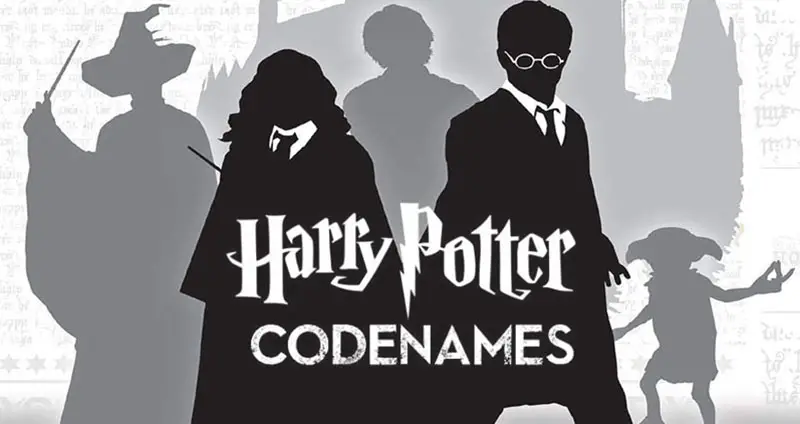
Limited Communication
Your information should be limited to what you can deduct from each other's clues. If you comment on your guess, don't give away any information about your side of the Key card.
If you guess a card that your partner marks as a red Order of the Phoenix Member, do not tell your partner what that card looks like on your side.
Do not give your partner advice on when to stop guessing, and do not tell your partner how many cards are left to guess unless all the cards you see as red have been covered by red Order of the Phoenix cards.
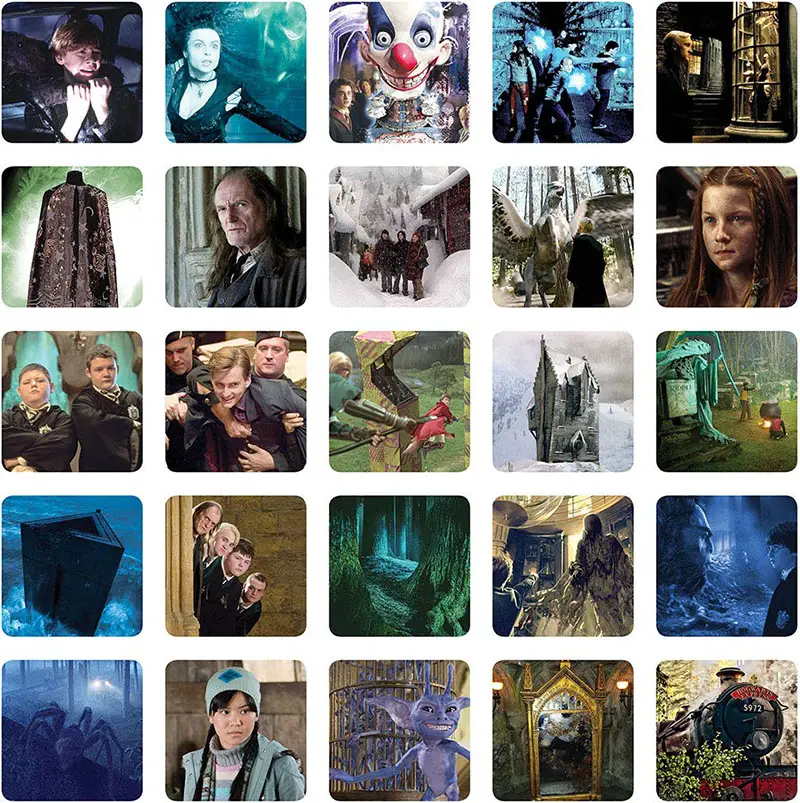
Regroup
You met a Death Eater
Yeah, this happens. You lost. That's what He-Who-Must-Not-Be-Named is hoping for. You can just deal a new set of cards, draw a new Key card, and try again.
Before giving a clue, always check the location of the three Death Eaters. Try to avoid a clue that could lead to one of those cards. Careful players can avoid the Death Eaters ... usually ... sometimes.
You Ran Out Of Time
Your sudden death turn ended on an incorrect guess and you failed to contact all the Order of the Phoenix Members. Do not give up - deal a new set of cards, draw a new Key card, and try again. T
o succeed, most of your clues need to connect two or more cards. Don't be afraid to give clues that are a bit of a stretch. Your partner knows that not every clue will be a perfect match. Just beware of the Death Eaters.
If you consistently run out of time, consider adding a 11th or 12th Time- Turner token. Maybe you need to practice on an easier mission before tackling the tougher challenges.
You won a mission with 11 or 12 tokens
Great! You played with some extra Time-Turner tokens, but you contacted all the Members while avoiding the Death Eaters. Mission complete!
We hope you enjoyed the game. You can play it this way again, or you can try it with 10 tokens. It may be tough,
and you might need several attempts or a bit of luck, but it feels great to beat that mission!
You won a standard 10-token mission
Awesome! You did great, and you are ready for anything!
The section on the next page explains how to use the Mission Log to find new challenges. The various missions require different skill levels and strategies.
Of course, you can also play the standard 11-token mission again. With so many Key cards and Code cards, each game will be completely different.
Scoring a 10-token mission
Some games are a struggle where you run into lots of Ministry Officials and have to use your sudden death turn to pull out a victory. Other games you might win in only 7 or 8 turns. You can evaluate how well you did by counting up your score:
Give yourselves 3 points for each Time-Turner token left in the time bank. (But do not forget that you also used a token on the last, victorious turn).
Give yourselves 1 point for each Time-Turner token that a player took when ending a turn after a correct guess.
Subtract 1 point if you needed the sudden death turn to win.
If you score more than 5 points, that's really good. A score of 9 or 10 is awesome. And if you can score more than 10, you really should give the Mission Log a try.
Mission Log
So, you just successfully completed a standard 10-token mission? Congratulations! (If you have not done that yet, keep trying. Return here when you succeed).
Your team is ready for more challenging missions. Take one of the Mission Logs from the pad. (There are multiple copies, so you can play missions with various teams). Mark the diamond next to London. You have just completed the 10/10 mission!
Now you are free to take the top mission within any of the three boxes in London. (Your choices are #4 Privet Drive, Diagon Alley, or Train Station). Here's what the numbers next to each mission mean:
Mission Parameters
Each mission has two number parameters. The first number is the total number of turns. When setting up a mission, put this many Time-Turner tokens in the time bank and leave the rest in the box. #4 Privet Drive uses 10, just like the standard London mission. While, Diagon Alley uses 11 and Train Station uses all 12 of the Time Turner tokens.
The second number is the number of acceptable mistakes. Only this many tokens are Ministry Official side up. The rest are flipped to the Time-Turner side. When setting up #4 Privet Drive for example, only 5 of the 10 tokens will be Ministry of Magic Official side up.

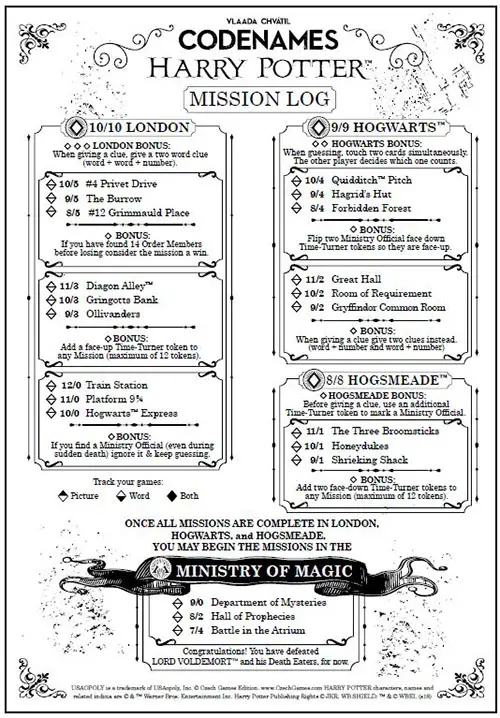
For the other missions, you will have a varying number of acceptable mistakes. Hogwarts 9/9 and Hogsmeade 8/8 are just like the standard mission, but with fewer tokens. You can choose to unlock those locations at any time to continue your journey. The final three missions in the Ministry of Magic cannot be attempted until all other missions are complete.
Within each of the three sections London, Hogwarts, and Hogsmeade are location specific bonuses. The number of diamonds indicates how many times you may use the bonus within that location. Additionally there are reward bonuses for completing a set of three missions. These may be used on any future mission regardless of the location.
Using The Time-turner Tokens
If the guesser chooses to stop guessing after one or more correct guesses, he or she takes a Time-Turner-side-up token from the time bank. If only Ministry Official-side-up tokens are left, the guesser takes one of these instead and places it Time-Turner side up on his or her side of the table.
If the turn ends by guessing a Ministry of Magic Official, the clue giver takes a Ministry Officialside-up token from the time bank and uses it to mark the incorrect guess, as usual. However, once you are out of Ministry Official-side-up tokens, wrong guesses are penalized.
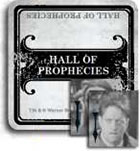
In this case, you mark a Ministry of Magic Official by removing two Time-Turner-side-up tokens and flipping them over to mark the Ministry Official. The mistake costs you two turns instead of one. (The stack of two tokens is treated the same as a single token).
Of course, if someone guesses a Death Eater, the Time-Turner tokens are irrelevant - you lose.
If a turn uses up your last token or your last two tokens, you play a sudden-death turn, as usual. However, if a turn causes you to use up more tokens than you have, you lose immediately. This will happen only when you have 1 Time-Turner token left, it is Time-Turner side up, and the guessing side guesses a Ministry Official.
Continuing On
When you win a mission in #4 Privet Drive, Diagon Alley, or the Train Station, mark it as complete. Another mission is unlocked and you can continue to the next location in the box. Once you have completed all the missions within a box, you unlock a bonus to use on a future game. These bonuses can only be used one time, then must be checked off. So, choose when is the best time to make use of them.
Different missions require different strategies. For some, you will need a very careful approach. Others reward bold clues and aggressive guessing.
Use the Mission Log the way that is the most fun for you. Perhaps you will find a few favorite missions and replay them again and again. Or maybe you will continue on, trying to complete them all.
If you are an expert Codenames player and want an even greater challenge, remove one Time-Turner token from each mission. Or, you may add an additional rule: for each set of three missions, one mission has to be played with pictures, one with words and one with combination of both.
Mark it by filling only upper half of the diamond if you used pictures  , lower half of the diamond for words
, lower half of the diamond for words  , and the entire diamond for both
, and the entire diamond for both  .
.
Valid and Invalid Clues
Some clues are invalid because they violate the spirit of the game. Your clue must be about the meaning of the words or pictures.
You can't use your clue to talk about the letters in a Code card or its position on the table. Middle: 1 is not a valid clue for the card in the middle
of the table. S: 3 is not a valid clue for three words that begin with S. Letters and numbers are valid clues, as long as they refer to meanings. You can use Seven: 2 as a clue for a picture of a Quidditch Team and one from the seventh movie.
But be careful when doing so. The number you say after your clue can't be used as a clue. Pink: 8 is not a valid clue for a picture of Dolores Umbridge and ARAGOG.
You can't say any form of a visible word on the table. If HARRY POTTER is visible, you can't say Harry, Pot, or Potting. But Potato is still okay. This rule only applies to the word side, if a picture of Harry Potter is visible, any of the clues above would be allowed.
A word is "visible" until it is covered by a red Order of the Phoenix card or two Time-Turner tokens representing an incorrect guess from each side. A Code card marked as an incorrect guess from only one side is still considered visible.
You can't say part of a compound word on the table. If GRAVEYARD is visible, you can't say Grave or Yard. But Gravel and Rave are okay. Similarly, if HORACE SLUGHORN is visible, you can't say Slug, Sluggish, Horn, or Horned. But Race is okay.
You are allowed to spell your clue. This can be helpful if you want to say Knight while avoiding things related to Night.
Accents, vocal inflections, and singing are not allowed. Don't say Candles in a French accent as a clue for GREAT HALL and MADAM MAXIME. And don't look up the French word for HALL. The only foreign words allowed are those you would use in an English-language conversation. (Banquet is okay). Proper names are okay, as long as they are one word. So, Snape is a valid clue, but Barty Crouch Jr. is not ... unless you think it should be.
Loosening up the rules
Barty Crouch Jr., The D.A., Little Whinging, Boxing Day, Sorcerer's Stone, House-Elf, and Dueling Club might all be good clues, but they break the rule that a clue must be one word.
It can be frustrating to have the perfect clue and not be able to use it. You can choose to relax the "one word" rule and allow multi- word names, acronyms, titles, and compound words.
You might also want to allow homonyms and other word play. Male: 2 is not strictly related to the meaning of HOWLER, but it could be a good clue for HOWLER and NEVILLE LONGBOTTOM.
English has a long tradition of word play, and you should feel free to use clues like this if they make the game more fun.
Penalty For Invalid Clue
If someone accidentally gives an invalid clue, you should take a one- turn penalty by discarding one of the Time-Turner tokens from the time bank. Then the guesser should guess as though the clue were valid.
So the turn ends in the usual way, which in most cases will use up another Time-Turner token. In some circumstances, an invalid clue might give away so much information that you decide it's better to start over with a clean game, but most of the time this penalty should be sufficient.
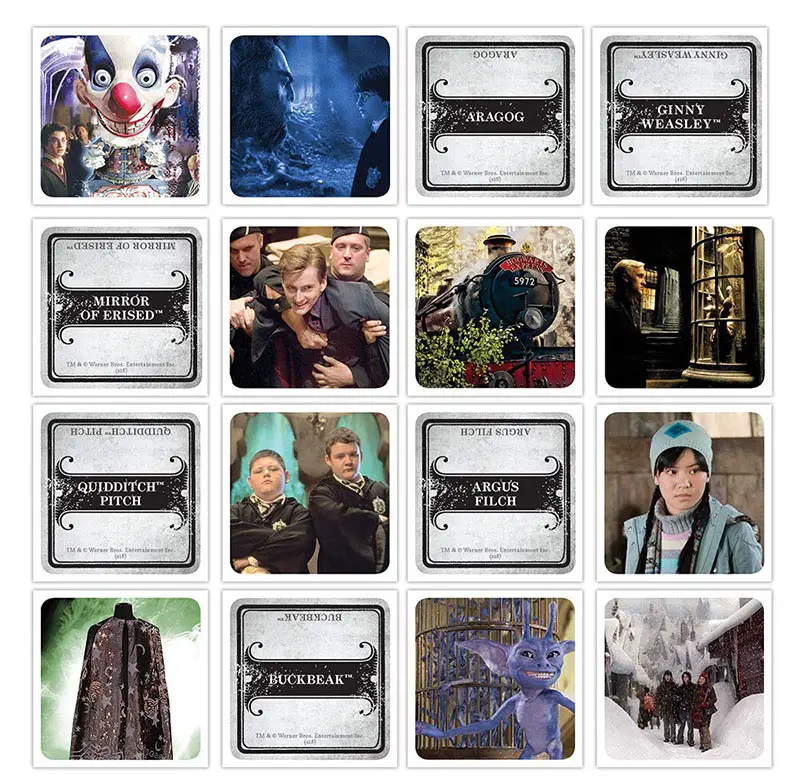
Advanced Technique: The Zero Clue
It is legal to give a clue for zero. For example, if you want your partner to guess CHO CHANG, CEDRIC DIGGORY, and GRYFFINDOR while avoiding the Death Eater DRACO MALFOY, you can give a clue like Slytherin: 0.
This will indicate that your partner should avoid MALFOY, and your partner might even be able to see that DRACO MALFOY is getting in the way of an easy clue like Houses: 3.
Even when your clue is for zero, your partner still must guess at least one Code card.
With more than 2 Players
This game was designed for 2 players, but in playtesting we had a lot of fun with larger groups. Players should divide into two sides sitting across from each other. Everyone should be able to see only one side of the Key card.
Gameplay is the same as for a two-player game. Anyone may give a clue, and all the players on the opposite side of the table are guessers. The clue-giving side may discuss the clue ideas, but they should not let the other side overhear.
You can whisper, write things down, or even leave the room, if you want. However, discussion is not required. Often it's easiest to just give the clue without discussion, if you think you have found a good one.
The guessing side may discuss their guess, but they should not say anything that would reveal information about their side of the Key card. As always, the guess is official only when one of the guessers touches the Code card.
Looser Turn Order
Some of our playtesters preferred a variant where the two players do not have to take turns. You can allow a player to give two clues in a row, if you like.
But then the other player should give a clue. To give all clues from one side before even starting to give clues from the other side is not in the spirit of the game.
Secrets of the Key Card
All Key cards are designed according to this diagram. You can use this knowledge to your advantage.

Of the 9 Code cards you see as red, 3 are also red on the other side of the Key card. That means together you have only 15 cards to guess. Note: Some players like to always place their Order of the Phoenix cards facing the guesser so they can keep track of who guessed which red cards.
Of the three Code cards you see as black, one is black, one is red, and one is grey on the other side of the Key card. This means that one Code card you see as black is a card you must guess. Furthermore, if you have found the black card that is red on the other side, you should not guess the other two black cards.
You can use the Clue cards from Codenames: Harry Potter with a Key card and Cover cards from another version of Codenames for a competitive game.
Things to Remember
Each turn consists of exactly one clue and one or more guesses. Your number of guesses is unlimited as long as you keep guessing correctly.
When a player touches a Code card, its identity depends only on the other player's side of the Key card.
Touching a grey Code card ends the turn. Touching a black Death Eater card ends the game.
A Code card marked by a Time-Turner token for one player may still be guessed by the other player. When it is marked both ways, it is considered covered.
Each turn costs you one Time-Turner token from the time bank. Either it is used by the clue giver to mark a Ministry of Magic Official the guesser touches, or it is taken by the guesser to indicate he or she is done guessing.
If you have not won the game after using your last Time-Turner token, you play a sudden death turn. Both players may guess, but no clue is given.
If anyone makes an incorrect guess, you lose the game.
When using the Mission Log, an incorrect guess might use up two Time-Turner tokens. This happens if you exceed the acceptable number of incorrect guesses. If you have only one token when you must give up two, you skip the sudden death turn and lose the game.
You must never reveal anything about your side of the Key card, except that you must tell your partner when all cards you see as red have been covered by red Order of the Phoenix cards.
Continue Reading


